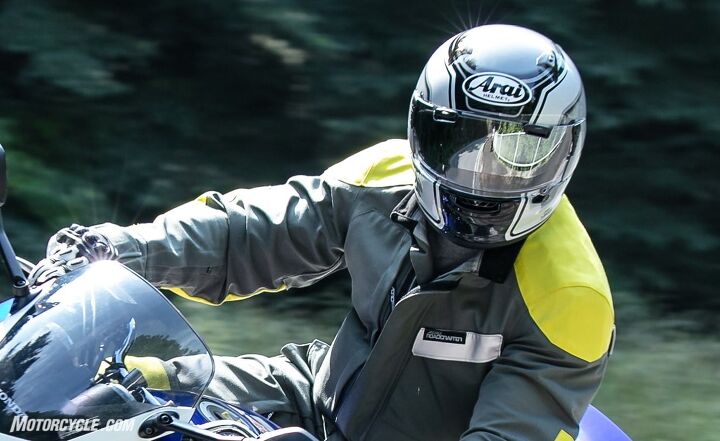MO Tested: Arai Regent-X Review

A more comfortable fit and a lower retail price with the same Arai protection
Arai was in a bit of a pickle. The company felt it was making the best helmets possible, but couldn’t get some riders to try them on. You see, the round shape of the Arai helmet made for a somewhat tight opening at the bottom of the helmet. Apparently, when trying on Arais, some folks were getting the helmet down to their ears and not liking how snug the opening was. Then they either decided not to try on the helmet or (worse) selected a larger size that slipped on easier but offered a less secure fit. Had they persisted and gotten the lid over their ears, they would have learned that the interior of Arais are as comfortable as you would expect from a helmet from a premium brand. This realization was the genesis for the Arai Regent-X.
Arai Regent-X Helmet
| Aesthetics | 9.0/10 |
| Protection | 10.0/10 |
| Value | 9.0/10 |
| Comfort/Fit | 9.5/10 |
| Quality/Design | 9.5/10 |
| Weight | 9.0/10 |
| Options/Selection | 8.75/10 |
| Innovation | 9.0/10 |
| Weather Suitability | 9.0/10 |
| Desirable/Cool Factor | 9.0/10 |
| Overall Score | 91.75/100 |
MO Tested: Arai Corsair-X Review
While the design goal of the helmet was to create the most comfortable helmet possible for folks with medium-oval heads, there are certain facets of their helmets that Arai refuses to change. The round shell shape is one feature. Mitigating rotational brain injuries is currently a hot topic among helmet manufacturers and users. Where other manufacturers, such as 6D and Bell, use internal means of absorbing rotational forces, Arai’s philosophy is that round shell shape prevents the forces from entering the helmet in the first place. According to Arai, the round shape prompts slides by glancing off objects. Other manufacturers that have angular features on the shell could dig in and generate the rotational forces we want to avoid. (This explains why Arai’s air intakes and diffusers are all lightweight plastic that will crush and rip free in a slide.)
With the Regent-X, the designers found that one seemingly small change, opening the chin bar on the front and the cheeks 5mm, made donning and doffing the helmet dramatically easier. The rest of the helmet’s fit is handled by Arai’s Facial Contour System.
The shell is a helmet’s first layer of defense against impacts, and Arai takes the construction very seriously. Every Arai shell undergoes two key inspections for weight, thickness, and uniform application of the structural materials. At these stations, the specially-trained technicians have absolute veto capability to jettison any shell that isn’t up to specification. (We’ll be posting a factory tour article that covers the entire construction process in the near future.) The Regent-X’s shell is made up of no less than 20 different pieces of material, each designed to deliver a different kind of impact resistance.
For example, the interior and exterior sections of the helmet are made of high-strength fibers that are randomly sprayed onto a headform, which Arai calls a bird’s nest because of its appearance in its unepoxied state. The random overlap of the fibers makes them extremely strong when fused together with resin. Between these two layers, fabrics and matts are sandwiched strategically to direct the crushing force of an impact outward along the shell’s surface, spreading out the force over a larger area. The eye port is the weakest portion of any helmet, but through its Formula One program, Arai developed and weaves its own super fabric that it places across the top of the opening to increase the strength of the shell in a process it calls Peripherally Belted Complex Laminate Construction. To ensure uniformity of the shells, the base and eye ports are laser cut by a specially developed robot. One of the changes Arai made to the process for the Regent-X was to utilize a new, less expensive resin as a cost saving measure – but without adding weight or reducing the level of protection offered. The end result creates a helmet that is both DOT and Snell M2020 certified – but more importantly, according to Arai, meets its stringent standards.
The interior of the shell is typical Arai. The energy-absorbing liner is constructed of a single piece of variable-density EPS, allowing the damping of forces to be tuned to the specific need of each section of the liner. To maintain a comfortable fit around the rider’s face, the Regent-X uses the latest iteration of Arai’s Facial Contour System. The pads themselves are articulated to allow easy entry and exit from the shell, but when the rider is wearing the helmet the pads pop back out to wrap around the rider’s face for a snug, noise-reducing fit. A variety of pads are available to tune the fit. I found the 20mm pads to be too narrow for my face, but the 25mm ones delivered just the right amount of snugness without forcing my cheeks into my teeth. The pads also offer speaker pockets for communication systems.
In the past, Arai’s visors were quite fussy to change. The current version, which is the same as used on the Corsair X, is much easier to master. I watched a helmet technician pop off and reinstall both sides of the visor simultaneously in just seconds. Quite an amazing feat – one which I was unable to repeat on my own. Since the Arai visor system is still a bit more complicated than many other helmets, I’ll have to practice to drop those times.
Since Arai doesn’t use internal tinted drop-down visors in its helmets (because the company believes it compromises impact protection in the forehead area), I decided to try the optional Pro Shade, which features a flip-up tinted visor attached to a clear one. The beauty of this setup is that, as I rode through tunnels – some of which were more than a mile long – I could flip away the tinted shield for better visibility. Even with the tinted portion in the peak-like up position, I never felt it interact with the wind at highway speeds. The Regent-X comes with the mounting posts for an optional Pinlock visor liner, and I was glad to have it installed on the introductory ride.
And then came the rain. Although the Arai-sponsored ride on motorcycles loaned to us by Honda Japan featured amazing roads (Riding in the left lane!) and spectacular scenery, the ride back to the Arai headquarters in Omiya is what I’ll always remember. The rain was some of the heaviest I have ever encountered on two wheels, and we rode from rural two-lane roads onto divided highways and into progressively more intense traffic as the freeways got closer to the urban sprawl that surrounds Omiya. Throughout it all, the visor remained watertight with nary a drip making its way to the interior. In both the rain and the hot, humid air before the storm, the Regent-X’s venting was quite good. The five intakes and six outlets flow a good amount of air without adding noise. In fact, the helmet ranks right up there with my Shoei GT Air II in terms of quietness.
In summary, my two days of riding in Japan with the Arai Regent-X were notable in a few details. First, the helmet’s fit allowed me to take off on an all-day ride, complete with extended periods of stop-and-go traffic in high temperatures and humidity – a situation that would make any fit issues come front-and-center – without any ill-effects or discomfort. Since then, the helmet has performed in a similar manner. The Regent-X felt like it was fully broken in from the first time I put it on. While I was never bothered by the tight opening of previous Arais I’ve tested, donning the Regent-X is noticeably easier. Second, the helmet is remarkably quiet at highway speeds with the vents open. (Comparable to the Shoei GT Air II but not quite as quiet as the 6D ATS-1R.) Finally, the Regent-X has the lowest retail price for a full-face Arai street helmet that I can remember. Solid colors cost $560, while graphics models tip the scales at $690. Sizing from XS-2XL is available. The Arai Regent-X will be available in December 2019.
We are committed to finding, researching, and recommending the best products. We earn commissions from purchases you make using the retail links in our product reviews and other articles. Learn more about how this works.

Like most of the best happenings in his life, Evans stumbled into his motojournalism career. While on his way to a planned life in academia, he applied for a job at a motorcycle magazine, thinking he’d get the opportunity to write some freelance articles. Instead, he was offered a full-time job in which he discovered he could actually get paid to ride other people’s motorcycles – and he’s never looked back. Over the 25 years he’s been in the motorcycle industry, Evans has written two books, 101 Sportbike Performance Projects and How to Modify Your Metric Cruiser, and has ridden just about every production motorcycle manufactured. Evans has a deep love of motorcycles and believes they are a force for good in the world.
More by Evans Brasfield
















































Comments
Join the conversation
Hey we're twins! (new stich color choice)
Like much in life, helmet preference is subjective. I buy Arai. I've bought Arai for decades. As far as I can tell in all probability, I'll continue to buy Arai. The quality, design, looks (Yes, looks.), and, most importantly, the fit and comfort is beyond anything else...for me. The long-oval fits me like a glove, the interior is the best in the biz, and they're just primo helmets. I ride way too much to forego any of that. So, you don't like 'em and/or prefer something else, awesome. Have at it. The Arai is absolutely worth the premium...again, for me. Great helmets! Live and let live.